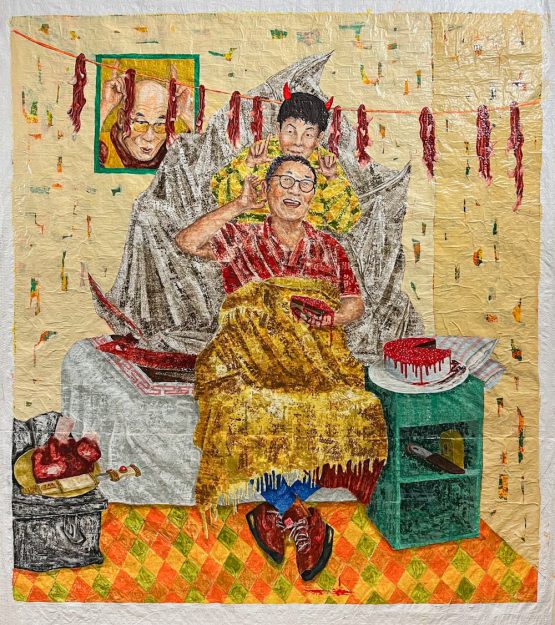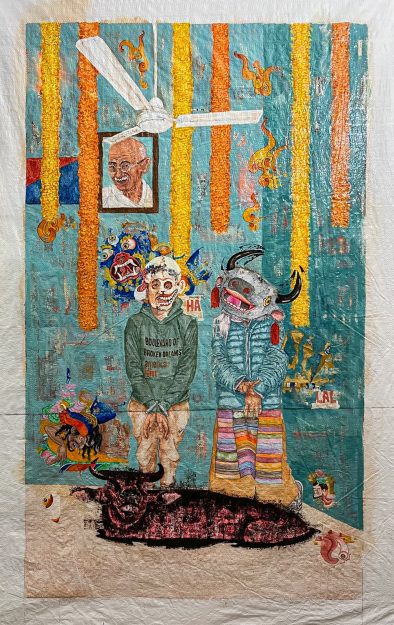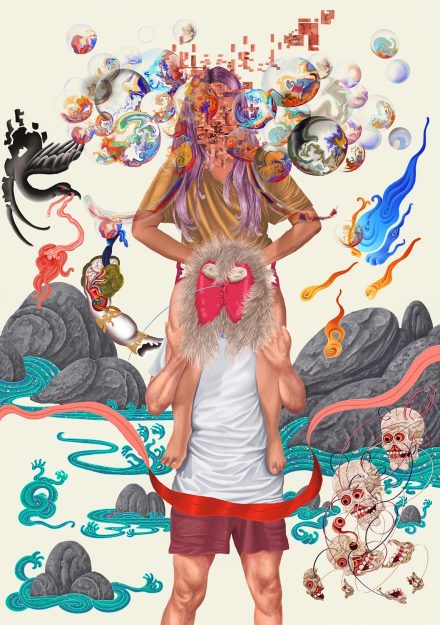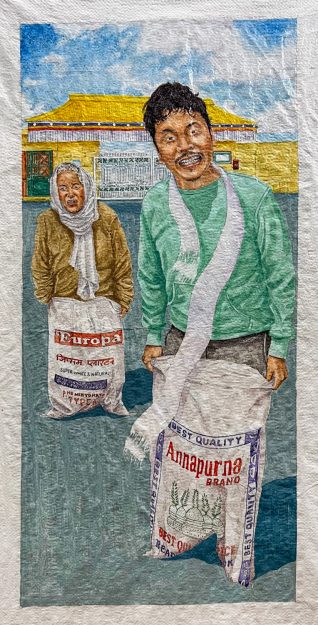YOUR CART
- No products in the cart.
Subtotal:
$0.00

In a recent solo exhibition at The Other Space gallery in McLeod Ganj, Dharamsala, India, minutes from the residence of the Fourteenth Dalai Lama, Tibetan artist Tenzin Gyurmey delivered a complex and layered body of work that wove together Indian and Tibetan exile culture, taboos, forbidden activities, proverbs, and spiritual iconography. Titled Behind the Two Mountains, the show featured imagery ranging from the surreal—people with baboon butts as heads—to the provocative—dried meat hanging in front of a portrait of the Dalai Lama.
As the son of a respected Tibetan tulku (a reincarnated master) thangka artist, Gyurmey grew up with social and religious pressures to behave in expected ways, but he was a bit of a rebellious misfit. The exhibition title refers to a place near his high school in Dharamsala, where he and others would hang out when doing naughty or forbidden things, such as smoking and meeting foreign girlfriends. Some of his paintings are potentially more risqué and controversial, and Gyurmey told me that others had criticized them without necessarily understanding his intentions or their meaning. “If you are creating something new, a sign that you are doing something is when people criticize you because you are provoking something,” he said. “It clashes with their long-held ideas and questions them.”
When we met for an interview, Gyurmey wore a sweater that said, “I like boring things,” an Andy Warhol quote referencing the mundane’s importance (and even beauty). It reminded me of Tibetan Buddhist master Chögyam Trungpa, who spoke of accepting and appreciating “cool boredom” as an essential part of the journey to full awakening. Yet, Gyurmey’s art and life are anything but boring.
Gyurmey became interested in art at an early age, but opportunities to follow his artistic passions were limited. Feeling pressured to do well by his family, teachers, and peers in India, he initially planned to study genetic engineering in college, but karma intervened. Encouraged by his sister, he returned to his love of art and enrolled at the College of Art in Delhi. During his studies, he met his mentor and inspiration, Tibetan contemporary artist Tsherin Sherpa, and held his first art exhibit at Sherpa’s art gallery in Kathmandu, Nepal. However, even as Gyurmey’s art started to receive attention and he was invited to show his work, his lack of financial resources and refugee status left him unable to travel for exhibitions. Not deterred by these challenges, Gyurmey has continued developing an artistic voice that is striking and mystifying, weaving together Tibetan and Indian symbols to create fantastical images.

Blessed features the artist in a room with his tulku father in the pose of the famous yogi Milarepa (who sang about the suffering of slaughtered animals), an image of the Fourteenth Dalai Lama, and pieces of drying meat. Gyurmey explained he had fond memories of this “blessed” time during his childhood when they all lived in one room and could not separate sacred objects from worldly ones. Blessed confronts ideas about what is pure and impure, the joys and challenges of a family living in a cramped space, the ethics of meat consumption, and the contradictory gap between Buddhist teachings and their real-life implementation.

A crime with mother portrays Gyurmey’s inner conflict about when he was young and traveled with his mother to purchase forbidden buffalo meat out of state. The symbolism in this work—such as the portraits looking on behind him of the Tibetan mythical figure Ashang Chogyel, taught to children to scare them into being good, and the Indian leader, avid vegetarian, and advocate of ahimsa (nonviolence) Mahatma Gandhi; handcuffed wrists; a half-skull face for himself; and a severed buffalo head on his mother—wrestle with the heavy weight of transgressing religious beliefs when confronting Buddhist and Hindu understandings of karma, interconnectivity, and eating animals. Plus, there’s the worldly fear of being arrested by the Indian police. Eating cow (or buff) meat in India is controversial and illegal in some places. As the cow is a sacred animal in Hinduism, such meat is banned in the Himachal Pradesh state, where Gyurmey lives.
Many Buddhists, including Tibetans, regard meat-eating as sacrilegious, impure, and cruel and make no hierarchical distinction between animals and humans. The English expression “sacred cow” also refers to a belief, custom, or convention considered above criticism due to social or religious pressure. In more ways than one, Gyurmey creatively tackles—directly and indirectly—the stories, influence, and power of the “sacred cows” in his culture and community.

A fusion of Indian and Tibetan themes is present in much of his work, and Gyurmey makes fun of the shaming of mixed-race and cross-cultural relationships in Rama-luk. Gyurmey explained that the Tibetan phrase rama-luk means neither a sheep nor a goat, so when someone dated a non-Tibetan, some people would say that their child was ramalug, not a pure breed. I asked Gyurmey what he thought about a notion of culturally and ethnically pure Tibetan-ness. “Identity is a very individual thing,” he told me. “All people have their own identities, what they have experienced, seen, and so on. Purity culture is like forcing people to come into one category, like this is Tibetan, this is Indian. They are forcing people to be in a homogeneous group and culture, but it is not.” He appreciates the natural richness, beauty, vitality, and aesthetic qualities of all the intercultural influences that make us unique individuals and human beings, especially in the global age of the internet and social media.

Some significant aspects of the cross-culture experiences expressed in his art are more subtle. Unable to afford pricey canvases, Gyurmey would paint on woven taupe-colored sacks, drochak-bhureh (barley sacks), used by the United States to deliver food to Tibetan refugees, transforming them into a poignant symbol of his journey as a Tibetan in exile and struggling artist. Gyurmey states on his website that:
To me, this material bears testament to the way the Tibetan diaspora has planted themselves in a new culture and undergone changes in their own culture. Through these works, I examine and celebrate the space we have created for ourselves as Tibetans in India.
Imaginatively illustrating the seemingly mundane life of a naughty Tibetan boy in exile, Gyurmey mixes interracial and ethnic relationships with Tibetan Buddhist iconography to create both uniquely Tibetan and globally relevant images that cross cultural and spiritual boundaries.